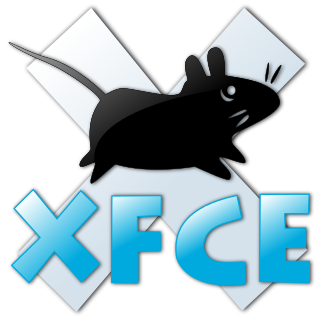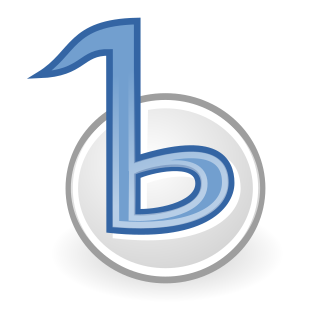
Xfce or XFCE is a free and open-source desktop environment for Linux and BSD operating systems.

Advanced Package Tool, or APT, is a free-software user interface that works with core libraries to handle the installation and removal of software on Debian, Ubuntu, and related Linux distributions. APT simplifies the process of managing software on Unix-like computer systems by automating the retrieval, configuration and installation of software packages, either from precompiled files or by compiling source code.

gedit is the default text editor of the GNOME desktop environment and part of the GNOME Core Applications. Designed as a general-purpose text editor, gedit emphasizes simplicity and ease of use, with a clean and simple GUI, according to the philosophy of the GNOME project. It includes tools for editing source code and structured text such as markup languages.

Optical disc authoring, including DVD and Blu-ray Disc authoring, is the process of assembling source material—video, audio or other data—into the proper logical volume format to then be recorded ("burned") onto an optical disc.

K3b is a CD and DVD authoring application by KDE for Unix-like computer operating systems. It provides a graphical user interface to perform most CD/DVD burning tasks like creating an Audio CD from a set of audio files or copying a CD/DVD, as well as more advanced tasks such as burning eMoviX CD/DVDs. It can also perform direct disc-to-disc copies. The program has many default settings which can be customized by more experienced users. The actual disc recording in K3b is done by the command line utilities cdrecord or cdrkit, cdrdao, and growisofs. As of version 1.0, K3b features a built-in DVD ripper.

Rhythmbox is a free and open-source audio player software, tag editor and music organizer for digital audio files on Linux and Unix-like systems.

Sound Juicer is the official CD ripper program of GNOME. It is based on GTK, GStreamer, and libburnia for reading and writing optical discs. It can extract audio tracks from optical audio discs and convert them into audio files that a personal computer or digital audio player can play. It supports ripping to any audio codec supported by a GStreamer plugin, such as Opus, MP3, Ogg Vorbis, FLAC and uncompressed PCM formats. Versions after 2.12 implement CD playing capability. Last versions produce lossy formats with default GStreamer settings.

GParted is a GTK front-end to GNU Parted and an official GNOME partition-editing application. GParted is used for creating, deleting, resizing, moving, checking, and copying disk partitions and their file systems. This is useful for creating space for new operating systems, reorganizing disk usage, copying data residing on hard disks, and mirroring one partition with another.

Banshee was a cross-platform open-source media player, called Sonance until 2005. Built upon Mono and Gtk#, it used the GStreamer multimedia platform for encoding, and decoding various media formats, including Ogg Vorbis, MP3 and FLAC. Banshee can play and import audio CDs and supports many portable media players, including Apple's iPod, Android devices and Creative's ZEN players. Other features include Last.fm integration, album artwork fetching, smart playlists and podcast support. Banshee is released under the terms of the MIT License. Stable versions are available for many Linux distributions, as well as a beta preview for OS X and an alpha preview for Windows.

Pitivi is a free and open-source non-linear video editor for Linux, developed by various contributors from free software community and the GNOME project, with support also available from Collabora. Pitivi is designed to be the default video editing software for the GNOME desktop environment. It is licensed under the terms of the GNU Lesser General Public License.
libburnia is a free software library and collection of command-line interface (CLI) for burning CDs, DVDs and Blu-ray media.

Buzztrax is a free software project to create a clone of the Buzz music composer. The driving motivation is to preserve the playability of the compositions made with Buzz. Songs are made by adding virtual sound generators and effects, connecting them, recording short musical phrases and arranging them in the sequencer. For distribution, songs can be exported to common audio formats such as OGG, MP3, WAV and many others.

GNOME is a free and open-source desktop environment for Unix-like operating systems. GNOME was originally an acronym for GNU Network Object Model Environment, but the acronym was dropped because it no longer reflected the vision of the GNOME project.

GNOME Videos, formerly known as Totem, is a media player for the GNOME computer desktop environment. GNOME Videos uses the Clutter and GTK+ toolkits. It is officially included in GNOME starting from version 2.10, but de facto it was already included in most GNOME environments. Totem utilizes the GStreamer framework for playback, though until version 2.27.1, it could alternatively be configured to use the Xine libraries instead of GStreamer.

DeVeDe is a free and open-source DVD and CD authoring utility. DeVeDe produces disk images ready for authoring to CD or DVD, and allows to burn them to CD/DVD discs. The source material may be in any of a number of audio and video formats, and DeVeDe automatically converts the material to formats compatible with audio CD and video DVD standards, as used by CD and DVD player devices. DeVeDe uses other software packages, including MPlayer, MEncoder/FFmpeg, DVDAuthor, VCDImager and mkisofs, to perform the format conversions, and can use K3b or Brasero to burn an ISO image on Ubuntu, or a variety of other software on Windows.
Express Burn Disc Burning Software is an optical disc authoring program for Windows and Mac. It allows users to burn audio, data, and video discs to CD, DVD, or Blu-Ray disc formats. Express Burn is a proprietary commercial software with a free version available for non-commercial use. Though originally released in 2002, the name "Express Burn" has been trademarked by NCH Software since 2010.

DeaDBeeF is an audio player software available for Linux, Android and other Unix-like operating systems. DeaDBeeF is free and open-source software, except on Android.

















